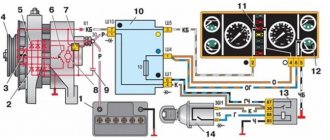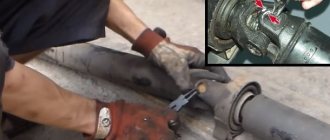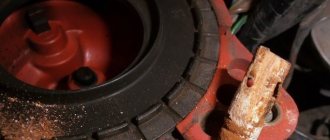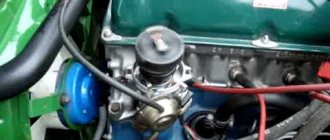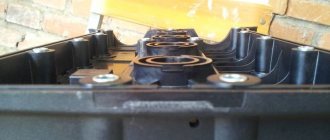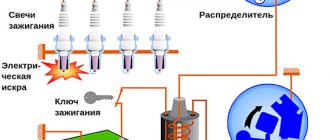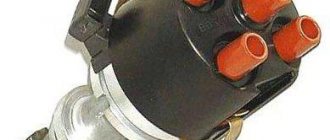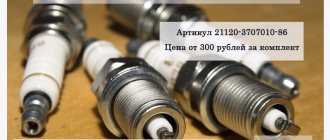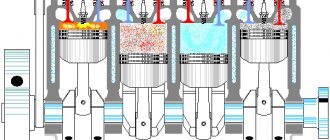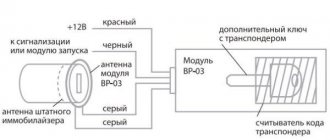Perhaps one of the most common questions among car owners is the following: how to ensure reliable, fast and safe engine starting? The car starting system acts as a kind of start during the operation of any car. This system must be in good condition so that you do not have to resort to such unfavorable methods as pushing the car in an attempt to start it. And one of the most significant components of the ignition system is the distributor. This is a slang name popular among drivers, and the "official" name is ignition distributor. This mechanism is truly indispensable in the overall design of the car, so it is very important to understand this and know how to diagnose faults in the distributor cover.
Distributor purpose
The distributor is a unique mechanism designed to determine the moment when high-voltage pulses begin to form in the ignition system. This device is used to distribute electric ignition among the cylinders of two types of gasoline internal combustion engines - injection and carburetor.
The distributor, by its nature, differs from other components in that its structure has a fairly large number of parts that wear out quickly. But the condition of this mechanism has a direct impact on the efficiency of the engine, as well as its starting characteristics. In addition, how efficiently the distributor works also affects the overall dynamics of the car and the toxicity of the exhaust.
As for the functions of this mechanism, there are two main ones:
- Interruption of the primary ignition circuit - in this way, the distributor provides current fluctuations in the primary winding of the coil, as a result of which a high level voltage appears in the primary part.
- Distribution of energy between the cylinder spark plugs in the required quantity and sequence.
The described mechanism is also indispensable because in its structure it has a number of mechanisms whose task is to change the ignition timing, which depends on the operating mode of the engine.
It should be noted that some cars, namely those with glow, diesel and compression engines, do not need a distributor for the simple reason that they have a different principle of ignition of the fuel-air mixture.
We find and fix the problem
It doesn't take much to get the ignition system in proper shape. Car manufacturers recommend periodically changing high-voltage wires, as well as ignition coils, not to mention spark plugs. If you have never done this before, then you may have all the signs of a faulty ignition coil. “Priora” or “Kalina” - nothing depends on the car, the symptoms are similar for all brands. Another thing is that on the same “Prior” the coil is of higher quality than on the “seven” or “kopek”, and breaks less often.
Symptoms of a problem
Before you begin repairing the mechanism being analyzed or the distributor cover, naturally, you should carefully check it. This will help you find out the specific cause of the problem and how to deal with it.
There are certain signs that indicate a malfunction in the distributor.
Their list included the following:
- While driving, the car jerks unusually and abnormally.
- The engine will not start.
- As the engine accelerates, the piston pins begin to knock.
- The car picks up speed very slowly.
- Fuel consumption increases significantly.
Naturally, the presence of any of the above symptoms does not yet give the right to say that the problem lies specifically in the ignition distributor. But if any of them is identified, you should begin to “sound the alarm” and, preferably, prepare to repair the distributor.
The list of the most common distributor malfunctions includes:
- A runner who went broke.
- Burnt contacts that are located in the distributor cover.
- Hall sensor failure.
- The Hall sensor bearing is stuck or loose.
- The appearance of cracks in the lid.
- The Hall sensor plug has poor contact.
- Oil gets into the distributor despite the presence of a protective cap.
It should be noted here that all types of the above problems with the distributor imply the replacement of faulty parts, in addition to the last two points.
Finding the reasons why it triples in wet weather
After inspecting the engine compartment and making sure that there are no obviously damp places or visible damage, we try to start it. It turns out only after 5-10 attempts, while it catches 4-6 times, and even then, these attempts are not always enough to get it started. Further, after a successful first start, the car shows no signs of breakdowns, but as soon as it sits and cools down, everything repeats itself. Only 5-10 km after the start, the car starts without problems.
There is also another popular method of checking what’s what, which will help you find the real problem. Try leaving your car overnight in a place not illuminated by street lights. Then, at night, open the hood and ask someone to do the key-to-start. You yourself need to stand and watch what is happening around the “high voltage”, explosive coils, distributor. There will be “Northern Lights”. You can read on a moonless night with such a glow.
Condensation in the distributor cap
After checking the spark plugs, injectors and fuel pump, and replacing the filter to calm things down, no defects were found. Apart from these factors, you seem to have nothing else to sin about. Although in fact there is no need to dig very deep, because most likely it is condensation in the distributor cap . The cover must be carefully inspected from the inside. As an experiment, try drying it, although the distributors are different on different engines, the vulnerability in them is the same. You need to wash the inside of the distributor cover first with gasoline (to degrease), then with 96% alcohol (to remove moisture).
Many people advise buying a new distributor right away, but don’t rush to buy and change everything ahead of time. According to the never-missing law of meanness, the last of the component parts will be guilty. Only at the extreme end the distributor cap needs to be changed, and with it the slider at the same time.
Repair
So, the car owner has identified certain malfunctions in the operation of the distributor and is ready to begin repairing this unit on his own. The first thing you need to know in this case is how to properly remove and install the distributor back. I recommend following these instructions:
- To begin with: check if sparks are visible when the engine is running. This can usually be done in the dark. If sparks are visible, this gives rise to an insulation violation. Also, the lid must be dry and clean, and it is prone to burning. In addition, I advise you to check the wire connections, that is, the integrity of the contacts. Therefore, the terminals in the cover should not be removed, at least without much effort.
- After completing the basic checks, remove the negative cable from the battery terminal.
- Disconnect the high-voltage wires and vacuum hose from the distributor.
- Remove the cable from the throttle valve drive.
- Together with the wires and studs, remove the bracket that holds the wires. To do this, unscrew the nut and under no circumstances lose it.
- Apply special marks to the housing, distributor cover and auxiliary device drives, which will help maintain the starting ignition timing during further installation of the described mechanism in place. Otherwise, it will need to be adjusted.
- Using a screwdriver, press the connector lock to which the drive harness is connected and pull out the drives.
- Pull out the rubber plug located in the clutch housing.
- Rotate the crankshaft until the piston of the first cylinder is at the top dead point. In this case, the flywheel mark should coincide with the middle division on the housing scale.
- Unscrew the nuts and remove this device together with the distributor cover.
- Installation is carried out in reverse order. Here we should remind you of the mandatory check of the alignment of the marks and the ignition timing.
The car owner should know that each wire on the distributor cover is installed in a certain sequence, which depends on the operation of the cylinders. So, of all of them, only the first one is indicated, and the rest must be installed by the driver himself, and this must be done counterclockwise. Another mandatory factor when carrying out this procedure is that the car enthusiast’s view should be from the side of the antifreeze tank, made of plastic.
An equally important point: if there is a need to replace the cover or slider, then dismantling the distributor itself is no longer required.
So, repair of the ignition distributor-distributor takes place in the following stages:
- Disconnecting high-voltage wires and removing the distributor from the vehicle.
- Removing the cover and carefully inspecting it. The fact is that it can be pierced (this is manifested by the presence of a thin dark strip), and this can only be eliminated by replacing it with a new one. Also, the central contact in it may fall out (it is also called a coal), which can be corrected in the same simple way - by replacing it with a new one.
- Checking the slider, which will also need to be replaced if there is a blown fuse and dark stripes, rust, or traces of burning.
- Remove the dust shield: remove the low voltage terminal by unscrewing the screw that secures it, then use a screwdriver to open the claws of the holder and remove the wires from it. Next, unscrew the two screws that secure the Hall sensor support plate and remove the latter. After this, pull out the retaining ring from the plate pin, which may require considerable force. Unscrew the screws that secure the vacuum corrector, then use a screwdriver to pull out its rod - now it can be completely removed from the distributor. The final step is to pull out the support plate and check the condition of its bushing. Ideally, there should not be any tears on it, and there should be no noticeable wear on it. Otherwise, there will be a need to completely replace this element.
- Remove the snap ring, the pressure pin that secures the coupling. If the sealing ring is torn, has lost its former elasticity or is completely worn out, urgently replace it. Drive the pin out of the coupling, remove it and the adjusting washers. This element needs to be replaced if its spikes are “licked off”.
- Remove the centrifugal regulator and roller. If backlash, wear, potholes, burrs, non-free rotation of loads, etc. are detected. — Replace the entire distributor body.
Repair of the distributor, despite the fact that it is considered a complex part and no less capricious, can be carried out on your own. Therefore, I advise you not to be afraid and try to complete this process, while being sure to follow the given instructions.
contact Group
Let us remind you that a distributor is needed only on carburetor internal combustion engines, because in injection systems it has long been abandoned precisely because of the high sensitivity of the unit to various types of influences. Instead, injection-type power plants use DPK - a crankshaft position regulator. But even in this case, if this sensor fails, the car will not start.
The distributor is located under the hood of the car (on the VAZ on the front passenger side). 5 armored wires are connected to it.
The distributor, in fact, includes a lot of elements, such as a vacuum sensor, a centrifugal regulator, etc. Each of these components can deteriorate, causing the distributor to malfunction or completely fail. But the most common “sore” of the distributor, of course, is related to the contacts.
Over time, the contacts of the distributor tend to oxidize, as a result of which the spark is no longer the same, the engine starts difficultly, with problems. Oxidized contacts are cleaned with white spirit, and if the cover is damaged, it must be replaced with a new one.
The contacts can also burn out, which is caused by poor engagement of the low voltage circuit. In this case, the current increases, which leads to direct burning of the contacts. Repairs are carried out: they are cleaned, and then all low-voltage connections are checked, the correct gap between the contacts is established.
One of the common symptoms of burning or oxidation of distributor contacts is the engine jerking at 2-4 thousand rpm. If you listen to how the internal combustion engine works in this case, you can clearly hear characteristic noises. In addition, when cold, the power plant starts extremely poorly. Cleaning the contacts eliminates all of these difficulties. The dynamics will improve, the car will no longer be “stupid”, causing unnecessary stressful situations for the driver.
Electrical discharges that occur when the distributor contacts open can cause corrosion and erosion. Corrosion, i.e., the formation of non-conducting films on contacts, and erosion is the transfer of the metal component from one contact to another. As a result of erosion, a tubercle can form on the contacts, and with corrosion, as mentioned, a film. Both options are a violation, which leads to missed flashes in individual engine cylinders.
After the same intermediate interval, it is customary to carry out lubrication work for the components and elements of the distributor. The procedures coincide in time, so it is recommended to perform them simultaneously.
What is a Hall sensor and how does it work
The Hall sensor (also known as a camshaft position sensor) is one of the main elements of the distributor. It is located next to the distributor shaft, on which a magnetically conductive plate, similar to a crown, is attached. There are as many slots in the plate as there are cylinders in the engine. There is also a permanent magnet inside the sensor.
The principle of operation of the Hall sensor is as follows: when the shaft rotates, metal blades alternately pass through a slot in the sensor. As a result, a pulse voltage is generated, which enters the ignition coil through the switch and, converted into high voltage, is supplied to the spark plugs.
The Hall sensor has three terminals:
When is there an option to repair?
If during testing both secondary windings show integrity and serviceability, the reason for the inoperability of the coils may be a break in the soldering of the switch wires. Such damage is detected when the rear cover of the module is removed. If you have a soldering iron and know how to use it, you can restore the integrity of damaged contacts, while at the same time strengthening the rest. This, unfortunately, is the only failure of the ignition module that can be repaired.
Testing the ignition module can be done using simple do-it-yourself instruments. Based on our advice, you will be able to fully check both the module itself and other elements of the mechanism that may be the cause of the breakdown. We wish you success in this matter!
Hall sensor replacement
Replacing the Hall sensor will not be particularly difficult. Even a novice car enthusiast can handle this work with his own hands.
The video below shows in some detail the process of replacing the sensor in the distributor of a UAZ car.
Typically, replacing a Hall sensor consists of several steps:
- First of all, the distributor is removed from the car.
- Next, remove the distributor cover and align the timing mechanism mark with the crankshaft mark.
- Having remembered the position of the distributor, you need to unscrew the fasteners with a wrench.
- If there are latches and stoppers, they should also be removed.
- The shaft is pulled out of the distributor.
- All that remains is to disconnect the terminals of the Hall sensor and unscrew it.
- By pulling back the regulator, the faulty part is carefully removed through the gap formed.
- The new Hall sensor is installed in the reverse order.
Checking the functionality of the Hall sensor not only allows you to accurately determine the cause of engine failure. Thanks to simple techniques, the motorist will save his time on repairs and also eliminate unnecessary waste of money.
Final tips
If the ignition system suddenly fails on the road, the internal combustion engine will stall instantly and the spark will disappear. There may also be several reasons for this.
- Most likely, the “woman”, i.e., the coil, has broken through. This problem can be solved simply - install a new coil, according to the markings indicated on the body.
- The central core of the VSKV wire that comes from the coil may burn out. The solution is to install a new armored wire.
- This situation may indicate burnout of additional resistance or failure of the slider. If the slider is broken, then you need to install a new one. If there are problems with additional resistance, it is pulled out of the slider and wrapped in cigarette foil.
Note. To determine the exact breakdown of the slider, you need to remove the distributor cover and the main armored wire. Then the latter must be held above the slider (distance 2 mm from the surface). We turn on the ignition - if a spark jumps between the slider and the wire, a breakdown of the slider is proven.
- It is quite possible that the protrusion of the moving part of the contacts may break or wear out. It is plastic and breaks easily. Its task is to ensure the opening of the contacts and the hammer spring. It is considered the most difficult malfunction to determine, since the usual spark test does not work here.
- Burning of contacts is complete. In other words, this is severe wear of the contact group.
- The lid is broken. In addition to microcracks, a large and wide crack can form on it. The only solution is to replace it with a new one.
Note. If a broken roof catches a motorist on the road, a clove of garlic will help. They should wipe the current crack to at least get to the nearest service station or store. Garlic juice has the ability to temporarily restore the functionality of the lid - this has been proven in practice.
- Contact group 3Z is faulty. A new one is installed, this is the only way to solve the problem. It is not difficult to provide access to the contact group; it will be enough to connect the wiring responsible for the ignition to each other and insulate them well.
As you can see, there are several reasons. They are considered the most common. It is their fault that the spark disappears and the dynamics of the car are lost.
As you know, one of the main components in any vehicle is the ignition system (IS), which, in turn, consists of many elements that perform different functions. If at least one of the SZ components fails, this will negatively affect the functionality of the engine as a whole. How to check the Golf 3 ignition coil and other system elements, what malfunctions are typical for SZ - find out from this material.
- 1 Ignition features
- 1.1 Typical system malfunctions and methods for eliminating them
1.2 Photo gallery “Schematic design of breakers for different Golfs”
System diagnostics
How to diagnose and replace high voltages, covers, and the runner of the distribution unit:
- First, all wires should be cleaned; to do this, they need to be treated with a damp cloth. It is necessary to carefully inspect each cable; if there is damage, the wire must be replaced.
- Before disconnecting the cables with a puller, check and remember their location. When disconnecting cables, you should carefully inspect the rubberized connecting wires; this is important.
- If you notice traces of corrosion on the contact sockets of the distributor cover, as well as the coil, these components need to be cleaned. To prevent corrosion, the cable ends can be treated with Vaseline (but with lubricant).
- You also need to dismantle the distributor cover along with the slider - carefully inspect the slider and the inner surface of the cover itself. If there are signs of burning or corrosion or wear, either the cover or the rotor is replaced. You should also carefully inspect the distribution assembly for sparking or cracking.
- When further installing high-voltage units, you should make sure that these elements are installed correctly, as this will affect the operation of the cylinders. Make sure that all connections are reliable and safe (video author - ICE Theory).
You can also diagnose the capacitor in a garage environment; to do this, follow these steps:
- First you need to dismantle the switchgear cover, the slider, and the boot, then you need to turn the motor until the contacts close. After this, the ignition should be turned off and the contacts themselves should be separated. If this step is accompanied by sparking, then this indicates a malfunction of the capacitor element.
- Then you need to diagnose the short circuit; to do this, remove the capacitor and connect a test light to it. The second wire from the control is connected to ground. If the light starts to light up, this indicates a malfunction of the element being diagnosed.
- If you have a new capacitor, try installing it instead of the old one. This is the most proven and effective diagnostic method. To dismantle the device, you need to unscrew the mounting bolt and then disconnect the wires. The installation procedure is carried out in reverse order.
Have you ever had to replace or repair an ignition coil?
- Yes, I repaired it
- Yes, I did
- Haven't encountered it
Capacitor
In addition to burning or oxidation of the contacts, the distributor capacitor may be to blame. It is installed parallel to the breaker for a specific purpose - to take on excess voltage, leading to burning of the contact group. It turns out that it is the capacitor that causes the burning and is associated with high spark formation or complete loss of spark.
Note. Complete failure of the distributor capacitor is rare, but it does happen from time to time.
To fix this problem, you don't need to invent anything. All you have to do is replace the capacitor and that's it. There are several ways to diagnose the correct functioning of a capacitor. Let's take a closer look at them.
- By the spark of candles. Indeed, to ensure the normal operation of the capacitor, you should verify the normal sparking of the SZ. If sparks produced by the spark plugs appear, but unevenly, this is the first sign that you need to pay attention to the distributor (especially if the color of the spark is faded red).
- According to the gaps between the contacts. In other words, if the gaps between the contacts are normal, then the likelihood of excessive sparking due to the capacitor increases significantly.
- On the lid. As in the case of the contact gap, if there are no microcracks on the cover through which dirt and dust get in, then interruptions in power transmission are associated, again, with the capacitor.
- Using a special device - an ammeter. It gives a more accurate “diagnosis” of the capacitor. The device is connected to the contacts, the indicators are checked. If the capacitor is faulty, the arrow of the device will be near 0 in the discharge position of 2-4 A.
- Using an ohmmeter and a portable lamp. The latter is taken and checked for mass by breakdown of the capacitor. You need to disconnect the capacitor wire from the breaker terminal, disconnect the coil wire and connect the carrier. If the capacitor is faulty, the lamp lights up as soon as the ignition system is turned on.
- A capacitor breakdown can also be detected by a spark formed after the two ends touch. If a spark appears between the ends of the wires, this indicates a breakdown of the capacitor.
- You can check the malfunction of the capacitor this way: charge the capacitor with high voltage, and then discharge it to ground. If a discharge spark appears directly between the housing and the wire, and a characteristic click is heard, the capacitor is working. But if there is no spark, or it is bad, then the capacitor is leaking and needs to be replaced.
In addition to these 7 ways, there are others.
- The crankshaft rotates after the condenser is turned off. Strong sparking between the contacts when starting the internal combustion engine is a clear indication of a faulty capacitor.
- Take an ohmmeter. The capacitor terminal is connected to the housing. One of the ends of the device is attached to the body, the other - to the tip of the wire. The ohmmeter itself is set to the highest measurement limit. When the capacitor is working properly, the arrow drops sharply towards 0, and then returns to the infinity symbol. Otherwise, the capacitor is considered broken.
The problem with the capacitor especially bothered drivers until 1961, when electrical equipment was made according to the plus-ground circuit. Modernization has clearly been beneficial. The electrical circuit was completely revised, and it was decided to use a minus-ground circuit.
